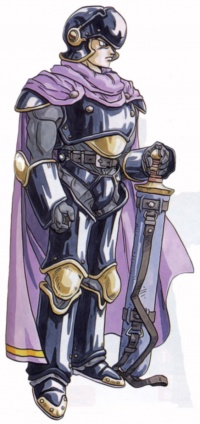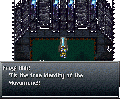Cyrus
Contents
General Information[edit]
Game Information[edit]
Chrono Trigger[edit]
Full Name: Cyrus
Japanese Name: サイラス
Age: Indeterminate, upper 20s
Species: Human
Home Time: 590 A.D., 1000 A.D.
Home Area: Choras, Guardia Castle, Northern Ruins
Cyrus was the leader of Guardia's knights and Glenn's mentor. He was known for being a fierce soldier and a kind-hearted, decent man. After joining the ranks of Guardia's knights, he became leader of the Knights of the Square Table and undertook various missions -- including the retrieval of the Hero's Medal from the Frog King and the discovery of the Masamune. Magus slew him after knocking the Masamune from his grasp. Magus then transformed Glenn into Frog in the aftermath. Frog recovered the Hero's Medal from the scene of the fight and dedicated his life to protecting the Kingdom of Guardia and avenging Cyrus. The old knight eventually came to haunt the Northern Ruins in a ghost's form. After finding his grave again in 600 A.D., Frog received a final blessing from Cyrus that inspired the Masamune to power up. Cyrus's final characterization is that of a powerful, heroic, upstanding knight -- a role model for the soldiery and citizenry alike. Cyrus has a unique tech in the Chrono series called Nirvana Strike, consisting of a powerful lunge against an enemy.
In the Chrono Trigger Prerelease, when Cyrus makes his final attack on Magus, he utters a cry not present in the final version.
サイラス・パーンチッ!!
"CYRUS PUUUNCH!!" If that sounds familiar, it's because サイラスパンチ is the exact name of Pierre's SlapofCyrus technique. It's too bad this reference was lost in the final version of Chrono Trigger.
Chrono Cross[edit]
Cyrus the Guardian Knight is mentioned again in Chrono Cross in Pierre's Tech skill SlapOfCyrus. However, If all parts of the Hero's set are not acquired and equipped on Pierre, the attack will always fail.
Theory and Analysis[edit]
Name Origin[edit]
The name Cyrus comes from Cyrus II the Great (576-529 B.C.), who was considered to be the first significant king of the Persian Empire of the period. Proving his mettle as a warrior, he overthrew his overlord and conquered the region. He was no less distinguished as a statesman than as a fighter -- the Charter of Cyrus the Great (537 B.C.), considered to be the first declaration of universal human rights, was discovered in 1879 in Babylon and is currently kept in the British Museum.
Cyrus II is also mentioned twenty-three times in the Old Testament of the Christian Bible. He is portrayed as the savior of the Jews, a people that at that time were in thrall to Babylon. He issued the decree of liberation for the Jews {Ezra 1:1-2), which allowed them to return and rebuild the Temple. The man was in a sense both a mentor and a warrior -- he gave his favor to the Biblical prophet Daniel.







